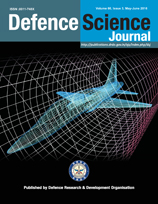Dynamic Analysis of HSDB System and Evaluation of Boundary Non-linearity through Experiments
DOI:
https://doi.org/10.14429/dsj.66.8936Keywords:
Natural frequency, random vibration, finite element analysis, power spectrum density, printed circuit boardAbstract
This paper deals with mechanical design and development of high speed digital board (HSDB) system which consists of printed circuit board (PCB) with all electronic components packaged inside the cavity for military application. The military environment poses a variety of extreme dynamic loading conditions, namely, quasi static, vibration, shock and acoustic loads that can seriously degrade or even cause failure of electronics. The vibrational requirement for the HSDB system is that the natural frequency should be more than 200 Hz and sustain power spectrum density of 14.8 Grms in the overall spectrum. Structural integrity of HSDB is studied in detail using finite element analysis (FEA) tool against the dynamic loads and configured the system. Experimental vibration tests are conducted on HSDB with the help of vibration shaker and validated the FE results. The natural frequency and maximum acceleration response computed from vibration tests for the configured design were found. The finite element results show a good correlation with the experiment results for the same boundary conditions. In case of fitment scenario of HSDB system, it is observed that the influence of boundary non-linearity during experiments. This influence of boundary non-linearity is evaluated to obtain the closeout of random vibration simulation results.
Downloads
Published
How to Cite
Issue
Section
License
 Where otherwise noted, the Articles on this site are licensed under Creative Commons License: CC Attribution-Noncommercial-No Derivative Works 2.5 India
Where otherwise noted, the Articles on this site are licensed under Creative Commons License: CC Attribution-Noncommercial-No Derivative Works 2.5 India


